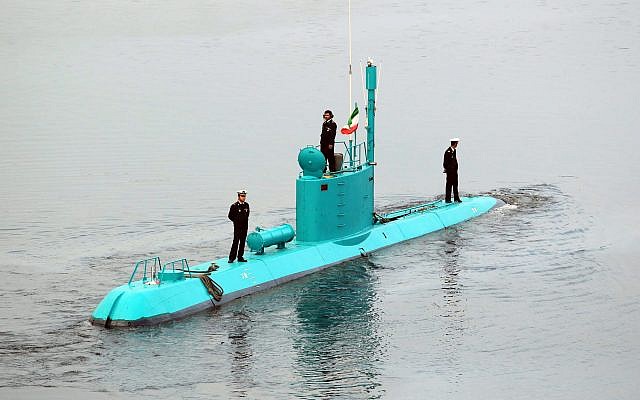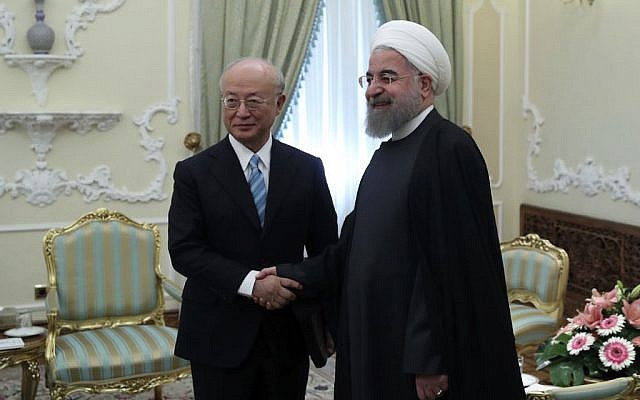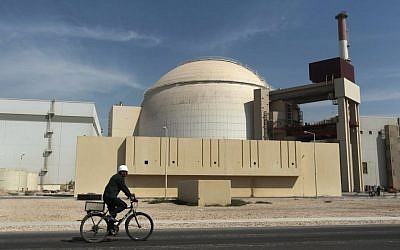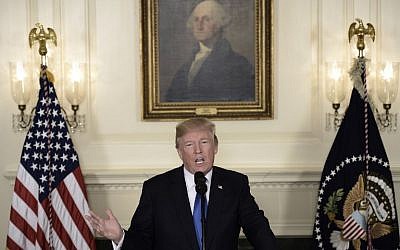IAEA report says Tehran compliant with nuke deal, downplays plans for naval nuclear vessels, which may require highly enriched uranium

Iran is still sticking to the 2015 nuclear accord, a UN atomic watchdog report showed Thursday, but noted Tehran is looking to develop seaborne nuclear capabilities.
The International Atomic Energy Agency document, the ninth since the deal came into force in January 2016, showed Iran complying with the accord’s key parameters, four months ahead of US President Donald Trump’s deadline to fix its “disastrous flaws.”
However, the IAEA report also said that Iran informed it in January by letter of a decision to “construct naval nuclear propulsion in future.”
The IAEA has asked Tehran for further details. Press reports in the past have said that Tehran wants to develop nuclear-powered ships and/or submarines.
This has created concern in the past because of the possibility that Iran might use highly enriched uranium, forbidden under the nuclear deal, to power such vessels.
In December 2016, Iranian President Hassan Rouhani ordered the country’s scientists to start work on nuclear-powered ships in response to the renewal of sanctions by the United States.
In letters read out on state television, Rouhani criticized the congressional move to renew sanctions as a breach of last year’s nuclear accord and told Iran’s Atomic Energy Organisation to start work on “planning the design and production of nuclear fuel and reactors for maritime transport.”
The 10-year-old sanctions legislation against Iran related not just to nuclear issues, but also ballistic missile-testing and human rights.
The IAEA downplayed Tehran’s plans; a senior diplomat at IAEA headquarters said the comments were likely “rhetoric” in response to Trump’s threats to rip up the deal.
The diplomat said Iran’s plans appeared vague for now and low-enriched uranium could be used for the nuclear naval vessels

“Everything in the letter only refers to the future. The indirect indication is that (actual designs) don’t exist,” the diplomat said.

Uranium when enriched to high purities can be used in a nuclear weapon. At low purities it can be used for peaceful applications such as power generation — Iran’s stated aim.
The IAEA report Thursday confirmed the number of centrifuges to enrich uranium was below the agreed level of 5,060, while Iran’s total stockpile of low-enriched uranium “has not exceeded 300 kg.”
The volume of heavy water, a reactor coolant, remained below the agreed maximum of 130 tons throughout the past three months.
Iran has inched above that ceiling twice since the enactment of the accord, known as the Joint Comprehensive Plan of Action (JCPOA).
It removed and rendered inoperable the core of the Arak reactor, which could in theory have produced weapons-grade plutonium, before the accord entered into force.
Aside from the relatively minor breach on heavy water, the IAEA reports have consistently shown Iran adhering to the deal in the two years since it took effect.
However, the future of the hard-won agreement between Iran and the five permanent members of the UN Security Council plus Germany is highly uncertain.
Trump in January set a 120-day deadline for US lawmakers and European allies to “fix” his predecessor Barack Obama’s main foreign policy achievement or face a US exit.
He is concerned that parts of the deal start to expire from 2026 and that it fails to address Iran’s missile program, its regional activities or its human rights abuses.
A US exit could kill the nuclear deal, which the Islamic Republic has refused to re-negotiate.

While Iran has reaped massive economic benefits from the accord, notably by being able to resume oil exports, it is still constrained by US sanctions in other areas.
Earlier on Thursday, Iran’s top nuclear negotiator warned that the agreement was under threat unless foreign businesses and banks were able to trade freely in the country.
Deputy foreign minister Abbas Araghchi told London’s Chatham House that Trump’s hostility toward the pact was creating a “destructive atmosphere” that meant businesses were afraid of dealing with Iran.
“As far as Iran is concerned, JCPOA is not a successful story,” he said. “Iran is not benefiting from sanction lifting in full.”
As reported by The Times of Israel
